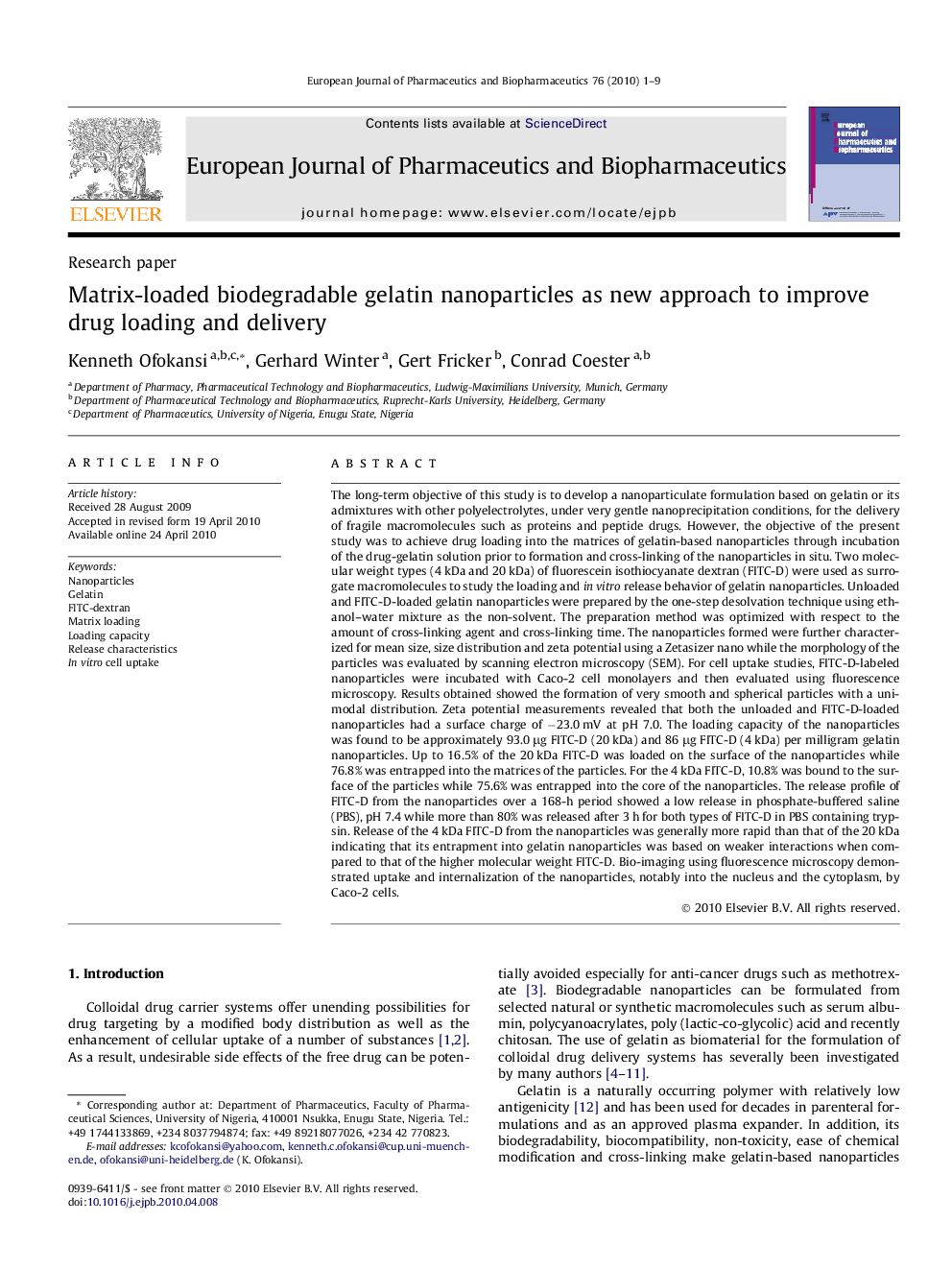| کد مقاله | کد نشریه | سال انتشار | مقاله انگلیسی | نسخه تمام متن |
|---|---|---|---|---|
| 2084285 | 1545376 | 2010 | 9 صفحه PDF | دانلود رایگان |

The long-term objective of this study is to develop a nanoparticulate formulation based on gelatin or its admixtures with other polyelectrolytes, under very gentle nanoprecipitation conditions, for the delivery of fragile macromolecules such as proteins and peptide drugs. However, the objective of the present study was to achieve drug loading into the matrices of gelatin-based nanoparticles through incubation of the drug-gelatin solution prior to formation and cross-linking of the nanoparticles in situ. Two molecular weight types (4 kDa and 20 kDa) of fluorescein isothiocyanate dextran (FITC-D) were used as surrogate macromolecules to study the loading and in vitro release behavior of gelatin nanoparticles. Unloaded and FITC-D-loaded gelatin nanoparticles were prepared by the one-step desolvation technique using ethanol–water mixture as the non-solvent. The preparation method was optimized with respect to the amount of cross-linking agent and cross-linking time. The nanoparticles formed were further characterized for mean size, size distribution and zeta potential using a Zetasizer nano while the morphology of the particles was evaluated by scanning electron microscopy (SEM). For cell uptake studies, FITC-D-labeled nanoparticles were incubated with Caco-2 cell monolayers and then evaluated using fluorescence microscopy. Results obtained showed the formation of very smooth and spherical particles with a unimodal distribution. Zeta potential measurements revealed that both the unloaded and FITC-D-loaded nanoparticles had a surface charge of −23.0 mV at pH 7.0. The loading capacity of the nanoparticles was found to be approximately 93.0 μg FITC-D (20 kDa) and 86 μg FITC-D (4 kDa) per milligram gelatin nanoparticles. Up to 16.5% of the 20 kDa FITC-D was loaded on the surface of the nanoparticles while 76.8% was entrapped into the matrices of the particles. For the 4 kDa FITC-D, 10.8% was bound to the surface of the particles while 75.6% was entrapped into the core of the nanoparticles. The release profile of FITC-D from the nanoparticles over a 168-h period showed a low release in phosphate-buffered saline (PBS), pH 7.4 while more than 80% was released after 3 h for both types of FITC-D in PBS containing trypsin. Release of the 4 kDa FITC-D from the nanoparticles was generally more rapid than that of the 20 kDa indicating that its entrapment into gelatin nanoparticles was based on weaker interactions when compared to that of the higher molecular weight FITC-D. Bio-imaging using fluorescence microscopy demonstrated uptake and internalization of the nanoparticles, notably into the nucleus and the cytoplasm, by Caco-2 cells.
SEM photomicrographs of FITC-D-loaded (A) and FITC-D-unloaded (B) gelatin nanoparticles showing very smooth and spherical particles. Note that the particles were prepared by the one-step desolvation method.Figure optionsDownload as PowerPoint slide
Journal: European Journal of Pharmaceutics and Biopharmaceutics - Volume 76, Issue 1, September 2010, Pages 1–9